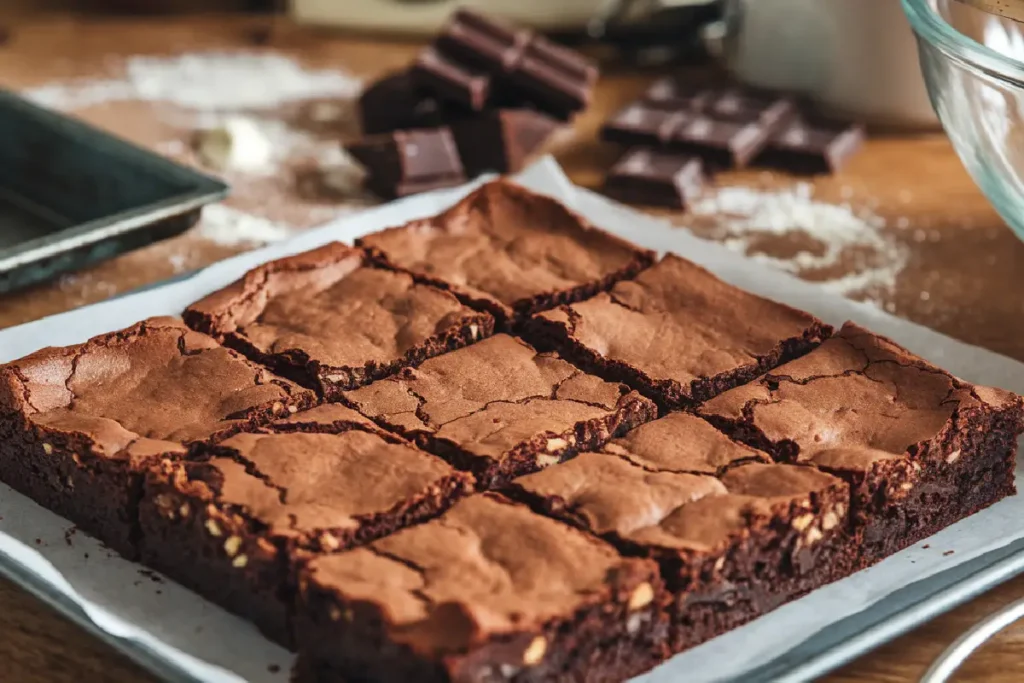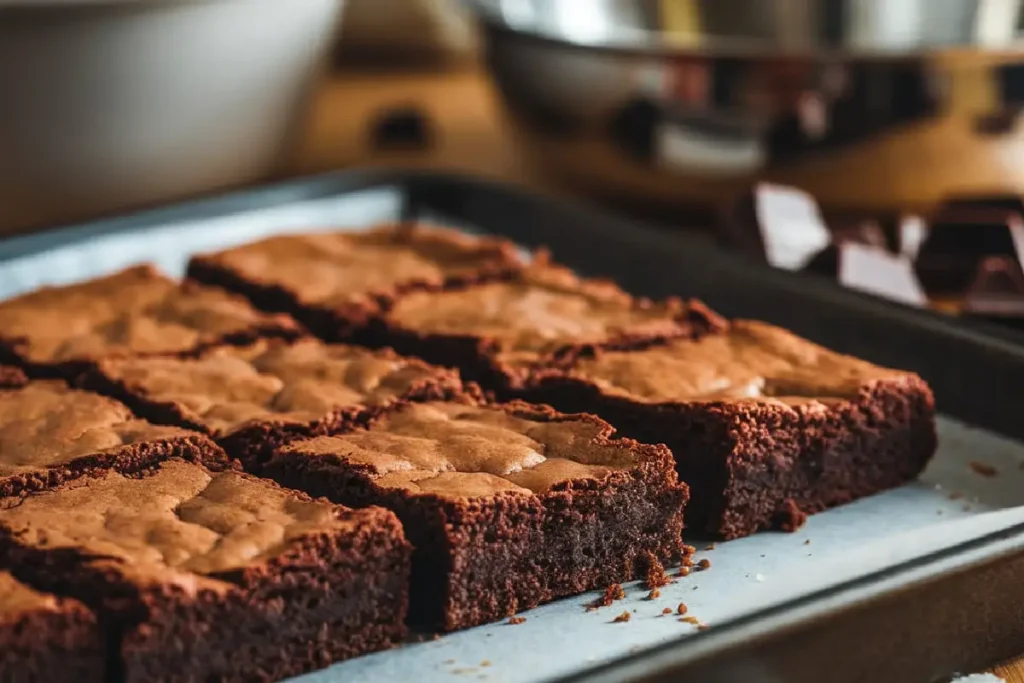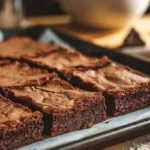Table of Contents: What Not to Do When Baking Brownies?
Introduction: What Not to Do When Baking Brownies?
There’s nothing worse than pulling a tray of brownies out of the oven, only to find they’re dry, crumbly, or worse—burnt to a crisp. We’ve all been there! Brownies are the ultimate comfort treat: fudgy, decadent, and guaranteed to turn a bad day into a chocolate-coated victory lap. But here’s the kicker: even tiny missteps can sabotage your batch. Did you know the first brownie recipe appeared in 1896, created by a chef who accidentally forgot to add baking powder to a chocolate cake? Talk about a happy accident!
This recipe isn’t just about avoiding disasters—it’s about mastering the art of chewy edges, crackly tops, and melt-in-your-mouth centers with minimal effort. Unlike our fussy-but-famous triple-layer chocolate cake, these brownies are weeknight-friendly, requiring just one bowl and 45 minutes start-to-finish. Whether you’re a baking newbie or a seasoned pro, let’s dodge those common pitfalls and bake brownies that’ll make your taste buds throw a party.
What Are Brownies?
Ah, brownies—the humble square of joy that’s neither cake nor cookie, but somehow better. Why are they called “brownies,” anyway? Legend says it’s because their rich, chocolatey hue resembles mythical woodland creatures (though we’re pretty sure it’s just because they’re… brown). Forget “the way to a man’s heart is through his stomach”—brownies are the way to everyone’s heart!
These bad boys are the superhero of desserts: no fancy frosting, no delicate layers—just pure, unapologetic chocolate bliss. Think of them as your chocolate chip cookie’s cooler, more sophisticated cousin. Ready to bake a batch that’ll make your kitchen smell like Willy Wonka’s factory? Let’s go!
Why You’ll Love This Recipe

- Foolproof Fudginess: Say goodbye to dry, cakey imposters. These brownies are all about that dense, fudgy texture thanks to melted butter and a touch of espresso powder (don’t worry—it just deepens the chocolate flavor!).
- Wallet-Friendly Wins: Skip the 6bakerybrownies!Thisrecipecostsunder6bakerybrownies!Thisrecipecostsunder10 to make and feeds a crowd.
- Endless Customization: Stir in walnuts, swirl caramel, or sprinkle sea salt on top. They’re as versatile as your Netflix queue.
Prefer something lighter? Try our matcha blondies for a twist. But trust us—these brownies are the MVP of dessert. Grab your whisk and let’s bake!
How to Make Perfect Brownies
Quick Overview
Ready in 45 minutes with 10 pantry staples, these brownies are impossible to mess up. The secret? A mix of cocoa powder and melted chocolate for double the richness.
Key Ingredients
- 1 cup unsalted butter (melted; skip the microwave—use a saucepan for deeper flavor!)
- 1 ½ cups granulated sugar (for that iconic crackly crust)
- 3 large eggs (room temperature = smoother batter)
- 1 tsp vanilla extract (the bourbon kind if you’re fancy)
- ¾ cup cocoa powder (Dutch-processed for intensity)
- ½ tsp espresso powder (optional, but game-changing)
- 1 cup all-purpose flour (spooned, NOT scooped!)
- ½ tsp salt
Step-by-Step Instructions
- Prep: Preheat oven to 350°F (175°C). Line an 8×8 pan with parchment paper—don’t skip this, or you’ll regret it later.
- Mix Wet Ingredients: Whisk melted butter, sugar, eggs, and vanilla until glossy (about 2 minutes).
- Add Dry Ingredients: Gently fold in cocoa, flour, salt, and espresso powder. Stop mixing once combined—overworking = tough brownies!
- Bake: Pour batter into pan. Bake 25-30 minutes. A toothpick should have crumbs, not be clean.
- Cool: Let them rest 20 minutes. Cutting too soon = gooey mess. Resist the urge!
What to Serve With Brownies
- Classic Combo: Vanilla ice cream + warm brownie = heaven.
- Gourmet Upgrade: Drizzle with salted caramel and crushed pistachios.
- Coffee Pairing: A bold espresso cuts through the sweetness.
Top Tips for Perfect Brownies
- Mistake #1: Overmixing: Stir until just combined—this isn’t bread dough!
- Mistake #2: Wrong Pan Size: An 8×8 pan ensures thickness. Using 9×13? You’ll get sad, flat squares.
- Mistake #3: Ignoring Oven Temp: Invest in an oven thermometer. Trust us.
Storing and Reheating Tips
- Room Temp: Store in an airtight container for 3 days.
- Freezing: Wrap slices in foil; freeze up to 3 months. Thaw overnight or microwave 20 seconds.
- Reheating: 10 seconds in the microwave revives that gooey center!
FAQs: What Not to Do When Baking Brownies?
Q: Can I use oil instead of butter in brownies?
A: Yes! Swap butter 1:1 with neutral oil (like vegetable or coconut) for denser, fudgier brownies. But butter adds richness—so choose based on your mood!
Q: Why did my brownies sink in the middle?
A: Overmixing or underbaking are the usual culprits. Follow the recipe’s mixing instructions and use a toothpick test (crumbs = perfect, wet batter = needs more time).
Q: Can I bake brownies in a glass pan?
A: Glass pans heat slower, so reduce oven temp by 25°F and add 5-10 minutes to baking time. Metal pans are foolproof for even baking!
Q: How do I make brownies less sweet?
A: Reduce sugar by ¼ cup or use dark chocolate (70%+ cocoa). A pinch of salt also balances sweetness.
Q: Can I freeze brownie batter for later?
A: Absolutely! Pour unused batter into a freezer-safe container and freeze up to 3 months. Thaw overnight before baking.
Conclusion: What Not to Do When Baking Brownies?

Let’s face it: even “simple” recipes can go sideways if you’re not careful. But now that you know what not to do when baking brownies, you’re armed with the secrets to avoid rubbery disasters, cracked tops, and sad, cakey imposters. Remember: perfect brownies are about patience (no overmixing!), precision (pan size matters!), and embracing the mess (because lickable batter is half the fun).
Whether you’re baking for a birthday, a bad day, or just because chocolate exists, this recipe is your ticket to fudgy, crackly-topped glory. So preheat that oven, grab your favorite mixing bowl, and let’s turn those “oops” moments into “OMG” ones. Don’t forget to tag us on Instagram with your masterpiece—we live for those gooey center shots!
Craving more baking wins? Dive into our Easy No-Churn Chocolate Ice Cream recipe next—it’s the ultimate sidekick to your brownie triumph. 🍫✨
Print
THE BEST Brownies
- Total Time: 45 mins
- Yield: 16 squares 1x
- Diet: Vegetarian
Description
Avoid dry, cakey disasters! These fudgy, crackly-topped brownies are rich, decadent, and foolproof. Learn the secrets to avoiding common mistakes (like overmixing or wrong pan sizes) for brownies so good, they’ll vanish before they cool. Perfect for beginners and chocolate lovers!
Ingredients
- 1 cup (227g) unsalted butter, melted
- 1 ½ cups (300g) granulated sugar
- 3 large eggs, room temperature
- 1 tsp vanilla extract
- ¾ cup (75g) Dutch-process cocoa powder
- ½ tsp espresso powder (optional, enhances chocolate flavor)
- 1 cup (125g) all-purpose flour (spooned & leveled)
- ½ tsp salt
- ½ cup (60g) chopped walnuts or chocolate chips (optional)
Instructions
- Prep: Preheat oven to 350°F (175°C). Line an 8×8-inch baking pan with parchment paper.
- Mix Wet Ingredients: Whisk melted butter, sugar, eggs, and vanilla in a large bowl until glossy (2 mins).
- Add Dry Ingredients: Gently fold in cocoa, flour, salt, and espresso powder until just combined (overmixing = cakey texture!).
- Bake: Pour batter into pan. Bake 25–30 mins—toothpick should have moist crumbs, not wet batter.
- Cool: Let cool 20 mins in pan, then lift parchment to transfer to a rack. Slice once fully cooled.
Notes
- Gluten-Free: Swap flour 1:1 with gluten-free blend (add ¼ tsp xanthan gum if needed).
- Storage: Keep in an airtight container for 3 days or freeze slices for 3 months.
- Pro Tip: For extra fudginess, replace ¼ cup flour with ¼ cup cocoa powder!
- Prep Time: 15 mins
- Cook Time: 30 mins
- Category: Dessert
- Method: Baking
- Cuisine: American
Nutrition
- Serving Size: 1 brownie
- Calories: 220
- Sugar: 20g
- Sodium: 85mg
- Fat: 12g
- Saturated Fat: 7g
- Unsaturated Fat: 4g
- Trans Fat: 0g
- Carbohydrates: 28g
- Fiber: 2g
- Protein: 3g
- Cholesterol: 55mg
Keywords: fudgy brownies, easy dessert recipe, homemade brownies, chocolate brownies

